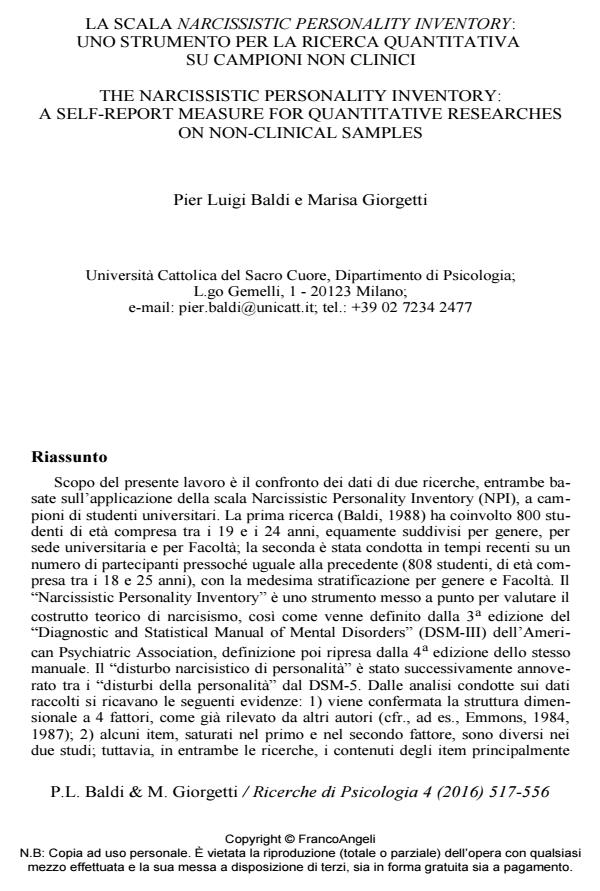La scala narcissistic personality inventory: uno strumento per la ricerca quantitativa su campioni non clinici
Titolo Rivista RICERCHE DI PSICOLOGIA
Autori/Curatori Pier Luigi Baldi, Marisa Giorgetti
Anno di pubblicazione 2017 Fascicolo 2016/4
Lingua Italiano Numero pagine 38 P. 517-554 Dimensione file 300 KB
DOI 10.3280/RIP2016-004004
Il DOI è il codice a barre della proprietà intellettuale: per saperne di più
clicca qui
Qui sotto puoi vedere in anteprima la prima pagina di questo articolo.
Se questo articolo ti interessa, lo puoi acquistare (e scaricare in formato pdf) seguendo le facili indicazioni per acquistare il download credit. Acquista Download Credits per scaricare questo Articolo in formato PDF

FrancoAngeli è membro della Publishers International Linking Association, Inc (PILA)associazione indipendente e non profit per facilitare (attraverso i servizi tecnologici implementati da CrossRef.org) l’accesso degli studiosi ai contenuti digitali nelle pubblicazioni professionali e scientifiche
Scopo del presente lavoro è il confronto dei dati di due ricerche, entrambe basate sull’applicazione della scala Narcissistic Personality Inventory (NPI), a campioni di studenti universitari. La prima ricerca (Baldi, 1988) ha coinvolto 800 studenti di età compresa tra i 19 e i 24 anni, equamente suddivisi per genere, per sede universitaria e per Facoltà; la seconda è stata condotta in tempi recenti su un numero di partecipanti pressoché uguale alla precedente (808 studenti, di età compresa tra i 18 e 25 anni), con la medesima stratificazione per genere e Facoltà. Il "Narcissistic Personality Inventory" è uno strumento messo a punto per valutare il costrutto teorico di narcisismo, così come venne definito dalla 3a edizione del "Diagnostic and Statistical Manual of Mental Disorders" (DSM-III) dell’American Psychiatric Association, definizione poi ripresa dalla 4a edizione dello stesso manuale. Il "disturbo narcisistico di personalità" è stato successivamente annoverato tra i "disturbi della personalità" dal DSM-5. Dalle analisi condotte sui dati raccolti si ricavano le seguenti evidenze: 1) viene confermata la struttura dimensionale a 4 fattori, come già rilevato da altri autori (cfr., ad es., Emmons, 1984, 1987); 2) alcuni item, saturati nel primo e nel secondo fattore, sono diversi nei due studi; tuttavia, in entrambe le ricerche, i contenuti degli item principalmente saturati nella prima componente (la quale spiega la percentuale maggiore di varianza), rimandano a tratti propri di chi non disdegna di sfruttare e/o manipolare gli altri; 3) nei due lavori si osservano risultati sovrapponibili relativamente alle differenze di genere e di Facoltà: i maschi sono più propensi ad assumere atteggiamenti e comportamenti di tipo narcisistico; indipendentemente dal genere, gli studenti di Giurisprudenza hanno medie di "narcisismo" più alte rispetto agli studenti di Lettere e Filosofia, le cui medie sono invece inferiori a quelle di tutte le altre Facoltà.
Parole chiave:Personalità, narcisismo, misura, studenti universitari
Pier Luigi Baldi, Marisa Giorgetti, La scala narcissistic personality inventory: uno strumento per la ricerca quantitativa su campioni non clinici in "RICERCHE DI PSICOLOGIA " 4/2016, pp 517-554, DOI: 10.3280/RIP2016-004004